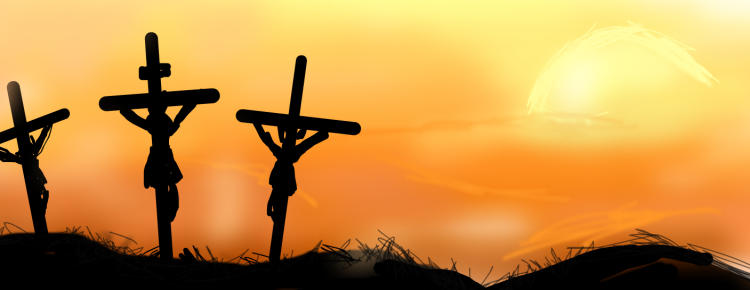Once again I’ve brought you some images as we seek, together, to deepen our understanding of Good Friday. These are all by Sieger Köder. Köder was a German Roman Catholic Priest and painter Sieger Köder: he died in February died 2015, shortly after his 90th birthday. His paintings were profoundly affected by his experiences as a prisoner of war and human suffering.
Köder’s work became world famous and he won many awards, including, in 1985, the honorary title of Monsignor and the Order of Merit from Pope John Paul II. He himself was a modest man and in a newspaper interview once said, ‘People come to Ellwangen asking to see the painter. If they’re that interested in the painter, then they haven’t understood the paintings’.
So, to the three paintings I’ve chosen for today:
The fist image, Jesus falls for the first time, is an image included in our Stations of the Cross posters – please have a look at the larger image before you leave today.
First, see Jesus, bowed down under the weight of the heavy beam he’s carrying – it’s thought that those, like Jesus, who carried the tool of their own death through the narrow, dirty streets of Jerusalem, carried only the cross beam – the upright shaft would already be in place, waiting for the next victim.
Here we see terrible human suffering being observed by shadowy onlookers. There’s the judge, grim faced but unmoved. Some of these people may be simply curious. And how often do we look on – bystanders to the suffering of the world – bystanders to Syria, bystanders to refugees in danger, passers by – unwilling to get involved or get our hands dirty, modern people with compassion fatigue unable to mend the world’s suffering.
But if you look more carefully you’ll notice that many of these shadowy onlookers seem to be in torment themselves – you can see one portrayed as addicted to alcohol, and others look grim faced and full of agony, the colours of life drained away.
Look again and you’ll see that all these people appear to be resting on the cross beam – Jesus is carrying the weight of the world on his shoulders – he’s carrying so much more than the crossbeam. He’s carrying lost, hopeless people. He’s carrying the one who doesn’t care that he’s condemned him to death. He’s carrying us too. This is our God, plumbing the depths of human suffering and pain, on the way to the cross.
The second image shows Jesus in the company of others as he carries his cross beam. If the first image showed Jesus carrying our suffering, here is Jesus sharing our suffering.
Suffering is an unavoidable part of human life. One part of this that clergy see often, when society at large perhaps doesn’t, is the huge number of people languishing in care homes, many of them lost or in torment, traumatised by having to leave the security of their own homes and feeling ‘dumped’ – out of the way and forgotten. Those who are for these people are almost always on incredibly low pay – somehow this seems to reflect how little we care.
In one way, God sharing our pain is irrelevant. What difference does it make? It will never make vulnerable people more valued, it will never give care workers a pay rise. It will probably never lessen anyone’s pain. At its worst ‘God understands your pain’ is utterly crass.
I think it does sometimes help if you’re in torment and someone understands. That’s why society is veined though with support groups of like people – those who have the same illness, have had similar experiences. There is solace there. When it comes to God sharing our pain, it is the ultimate solace – God is here with us, sharing our suffering. And somehow, in the great reckoning at the end of everything, that suffering must be accounted for and brought to resolution. In the purple cloak we see Joseph of Arimathea, crawling in to the midst of the suffering – another image of God, perhaps, crawling into our midst – God is always to be found, in life as in death with the outcast, the sick, the unclean, the suffering.
The final image -The Crucified One speaks to our grief. It takes our memories back to something we remembered only a few weeks ago -the beautiful Feast
of Candlemas where Simeon told Mary ‘A Sword will pierce your own soul too’. Here is that time of piercing – the time of pain at the loss of a loved one. Look at the love in those faces – look at the grief.
Here we see that love and grief are connected – we grieve only because we love. We see the beginning of care for Jesus’ body – the women with linen cloths and scented oils are waiting in the wings somewhere. Here we learn that matter matters – our bodies matter, are precious and beloved.
And we wait for the next image – the image of Easter Day, the image of Mary at the empty tomb, the disciples on the road to Emmaus, the Fishermen leaping out of their boat to get to shore where Jesus is cooking fish over a fire.
Our observance of Holy Week always needs to remember that the suffering and pain ended in resurrection. This our hope for our loved ones who have died, for those lost souls in residential homes, for those who mourn and are full of life. We have to look forward to the empty tomb, the folded linen cloths and that moment of recognition – Jesus is here, alive, with us.

